Managerial Finance Report: Analysis of Capital Structure and Payout
VerifiedAdded on 2023/04/03
|10
|1200
|369
Report
AI Summary
This report provides an analysis of managerial finance, addressing key concepts such as the time value of money (TVM), capital structure, and payout policies. The report examines how companies utilize TVM in long-term service provisions and impairment valuations, emphasizing the importance of discount rates. It then delves into capital structure, comparing debt and equity financing, and evaluates the implications of high debt levels. Furthermore, the report scrutinizes payout policies, specifically comparing dividend yields of Telstra and TPG Telecom, and assesses Telstra's dividend strategy relative to its competitors and industry benchmarks. The analysis highlights the significance of capital structure optimization, payout strategies, and their impact on shareholder value, offering a comprehensive overview of corporate financial management.

Running head: MANAGERIAL FINANCE
Managerial finance
Name of the student
Name of the university
Student ID
Author note
Managerial finance
Name of the student
Name of the university
Student ID
Author note
Paraphrase This Document
Need a fresh take? Get an instant paraphrase of this document with our AI Paraphraser
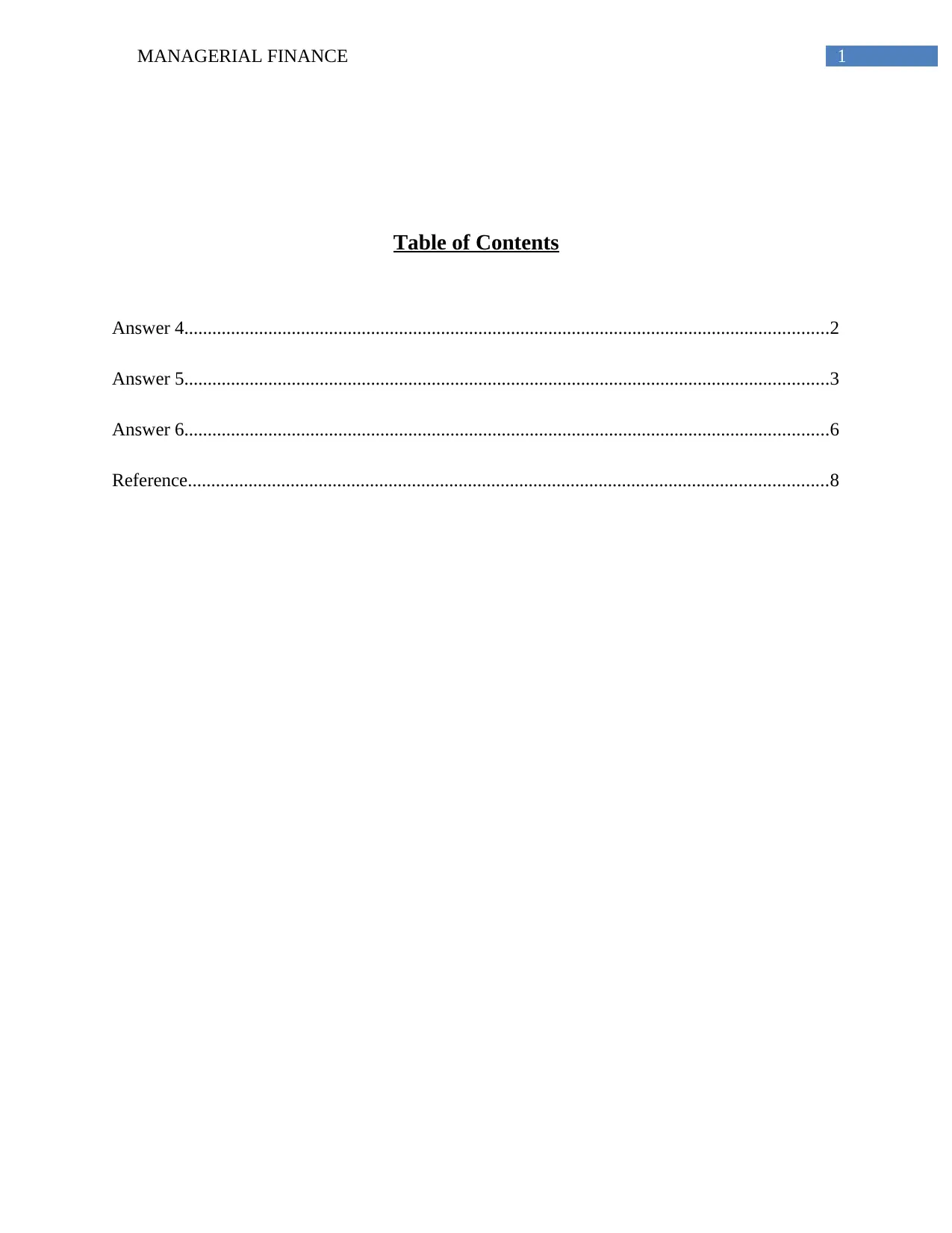
1MANAGERIAL FINANCE
Table of Contents
Answer 4..........................................................................................................................................2
Answer 5..........................................................................................................................................3
Answer 6..........................................................................................................................................6
Reference.........................................................................................................................................8
Table of Contents
Answer 4..........................................................................................................................................2
Answer 5..........................................................................................................................................3
Answer 6..........................................................................................................................................6
Reference.........................................................................................................................................8
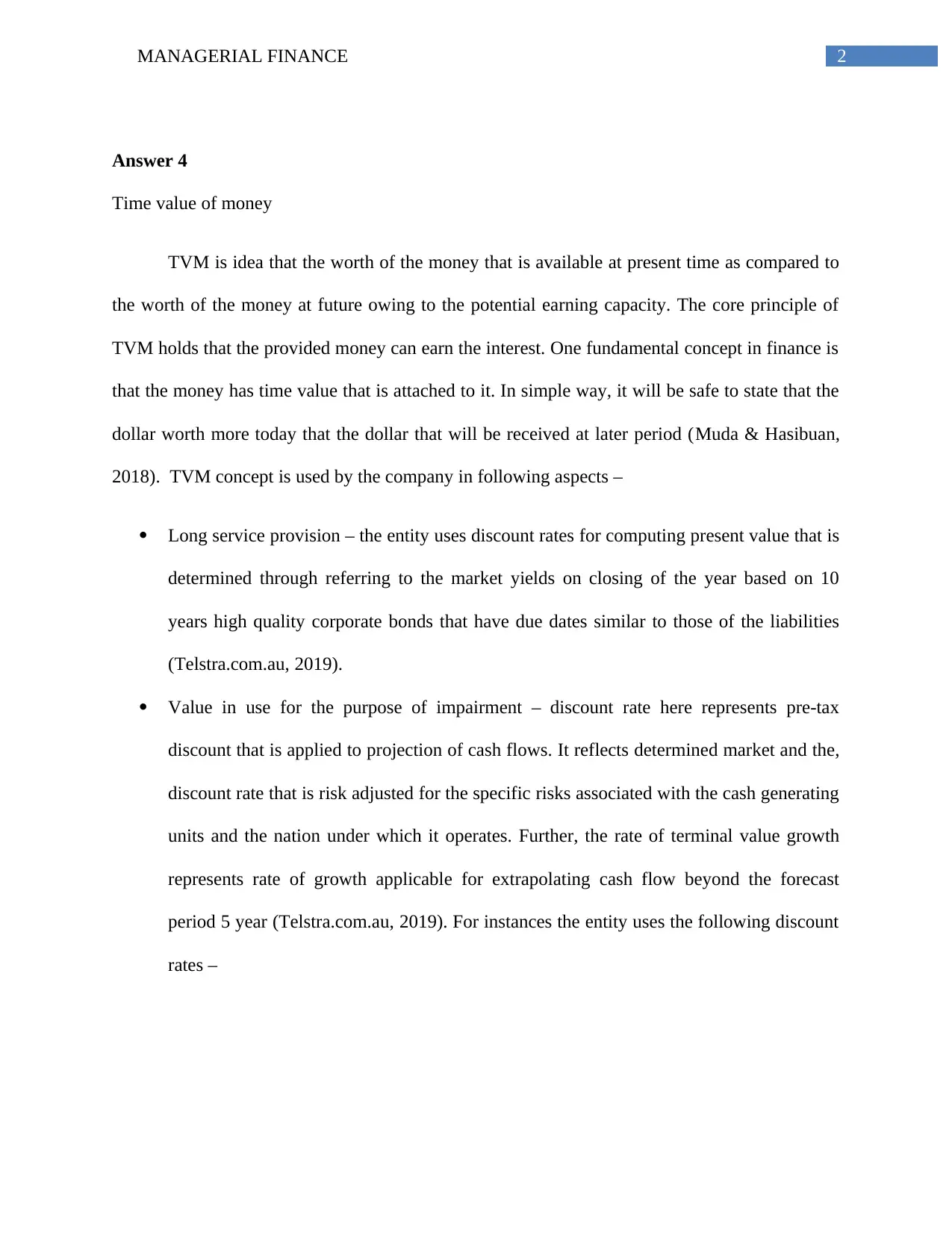
2MANAGERIAL FINANCE
Answer 4
Time value of money
TVM is idea that the worth of the money that is available at present time as compared to
the worth of the money at future owing to the potential earning capacity. The core principle of
TVM holds that the provided money can earn the interest. One fundamental concept in finance is
that the money has time value that is attached to it. In simple way, it will be safe to state that the
dollar worth more today that the dollar that will be received at later period (Muda & Hasibuan,
2018). TVM concept is used by the company in following aspects –
Long service provision – the entity uses discount rates for computing present value that is
determined through referring to the market yields on closing of the year based on 10
years high quality corporate bonds that have due dates similar to those of the liabilities
(Telstra.com.au, 2019).
Value in use for the purpose of impairment – discount rate here represents pre-tax
discount that is applied to projection of cash flows. It reflects determined market and the,
discount rate that is risk adjusted for the specific risks associated with the cash generating
units and the nation under which it operates. Further, the rate of terminal value growth
represents rate of growth applicable for extrapolating cash flow beyond the forecast
period 5 year (Telstra.com.au, 2019). For instances the entity uses the following discount
rates –
Answer 4
Time value of money
TVM is idea that the worth of the money that is available at present time as compared to
the worth of the money at future owing to the potential earning capacity. The core principle of
TVM holds that the provided money can earn the interest. One fundamental concept in finance is
that the money has time value that is attached to it. In simple way, it will be safe to state that the
dollar worth more today that the dollar that will be received at later period (Muda & Hasibuan,
2018). TVM concept is used by the company in following aspects –
Long service provision – the entity uses discount rates for computing present value that is
determined through referring to the market yields on closing of the year based on 10
years high quality corporate bonds that have due dates similar to those of the liabilities
(Telstra.com.au, 2019).
Value in use for the purpose of impairment – discount rate here represents pre-tax
discount that is applied to projection of cash flows. It reflects determined market and the,
discount rate that is risk adjusted for the specific risks associated with the cash generating
units and the nation under which it operates. Further, the rate of terminal value growth
represents rate of growth applicable for extrapolating cash flow beyond the forecast
period 5 year (Telstra.com.au, 2019). For instances the entity uses the following discount
rates –
⊘ This is a preview!⊘
Do you want full access?
Subscribe today to unlock all pages.

Trusted by 1+ million students worldwide
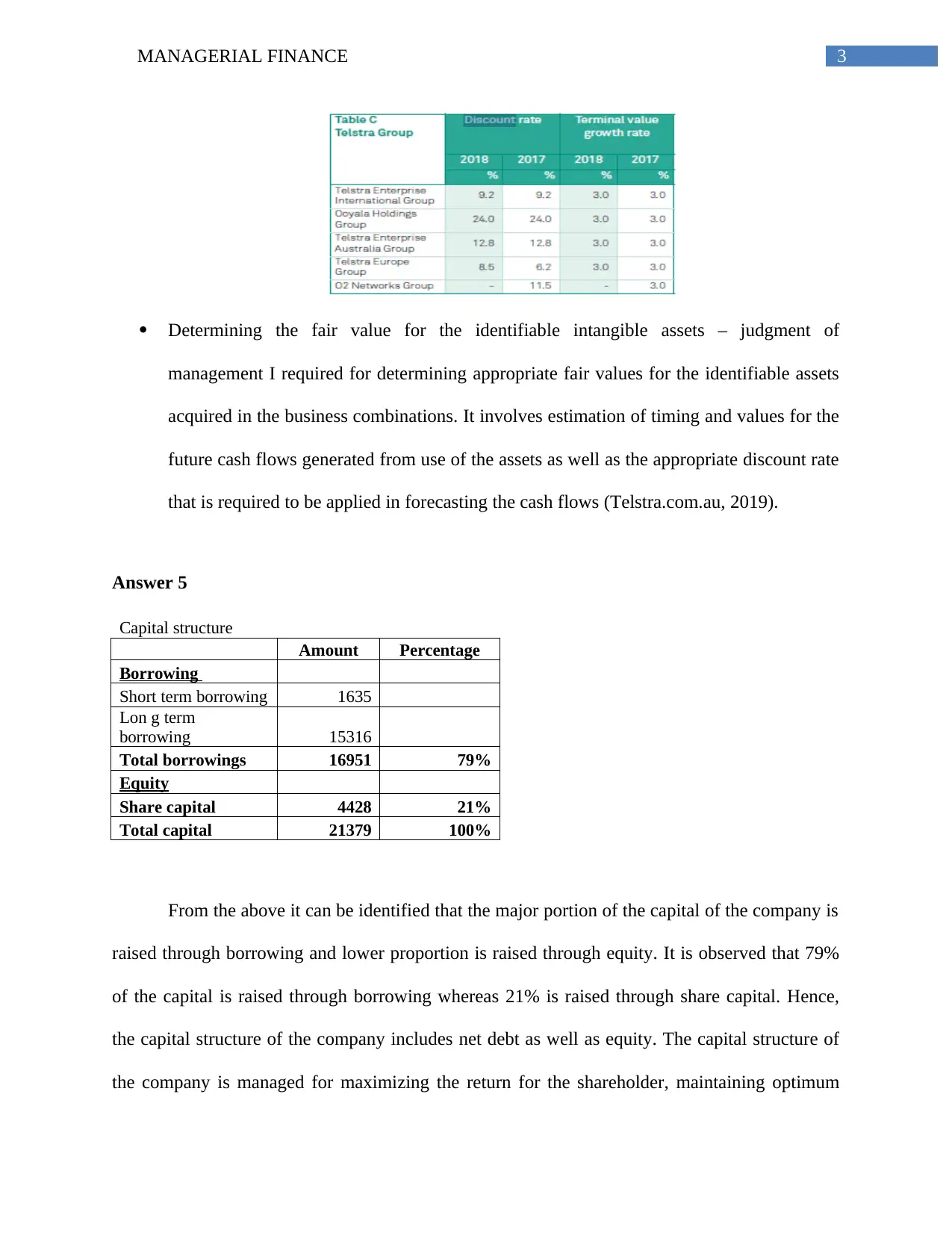
3MANAGERIAL FINANCE
Determining the fair value for the identifiable intangible assets – judgment of
management I required for determining appropriate fair values for the identifiable assets
acquired in the business combinations. It involves estimation of timing and values for the
future cash flows generated from use of the assets as well as the appropriate discount rate
that is required to be applied in forecasting the cash flows (Telstra.com.au, 2019).
Answer 5
Capital structure
Amount Percentage
Borrowing
Short term borrowing 1635
Lon g term
borrowing 15316
Total borrowings 16951 79%
Equity
Share capital 4428 21%
Total capital 21379 100%
From the above it can be identified that the major portion of the capital of the company is
raised through borrowing and lower proportion is raised through equity. It is observed that 79%
of the capital is raised through borrowing whereas 21% is raised through share capital. Hence,
the capital structure of the company includes net debt as well as equity. The capital structure of
the company is managed for maximizing the return for the shareholder, maintaining optimum
Determining the fair value for the identifiable intangible assets – judgment of
management I required for determining appropriate fair values for the identifiable assets
acquired in the business combinations. It involves estimation of timing and values for the
future cash flows generated from use of the assets as well as the appropriate discount rate
that is required to be applied in forecasting the cash flows (Telstra.com.au, 2019).
Answer 5
Capital structure
Amount Percentage
Borrowing
Short term borrowing 1635
Lon g term
borrowing 15316
Total borrowings 16951 79%
Equity
Share capital 4428 21%
Total capital 21379 100%
From the above it can be identified that the major portion of the capital of the company is
raised through borrowing and lower proportion is raised through equity. It is observed that 79%
of the capital is raised through borrowing whereas 21% is raised through share capital. Hence,
the capital structure of the company includes net debt as well as equity. The capital structure of
the company is managed for maximizing the return for the shareholder, maintaining optimum
Paraphrase This Document
Need a fresh take? Get an instant paraphrase of this document with our AI Paraphraser
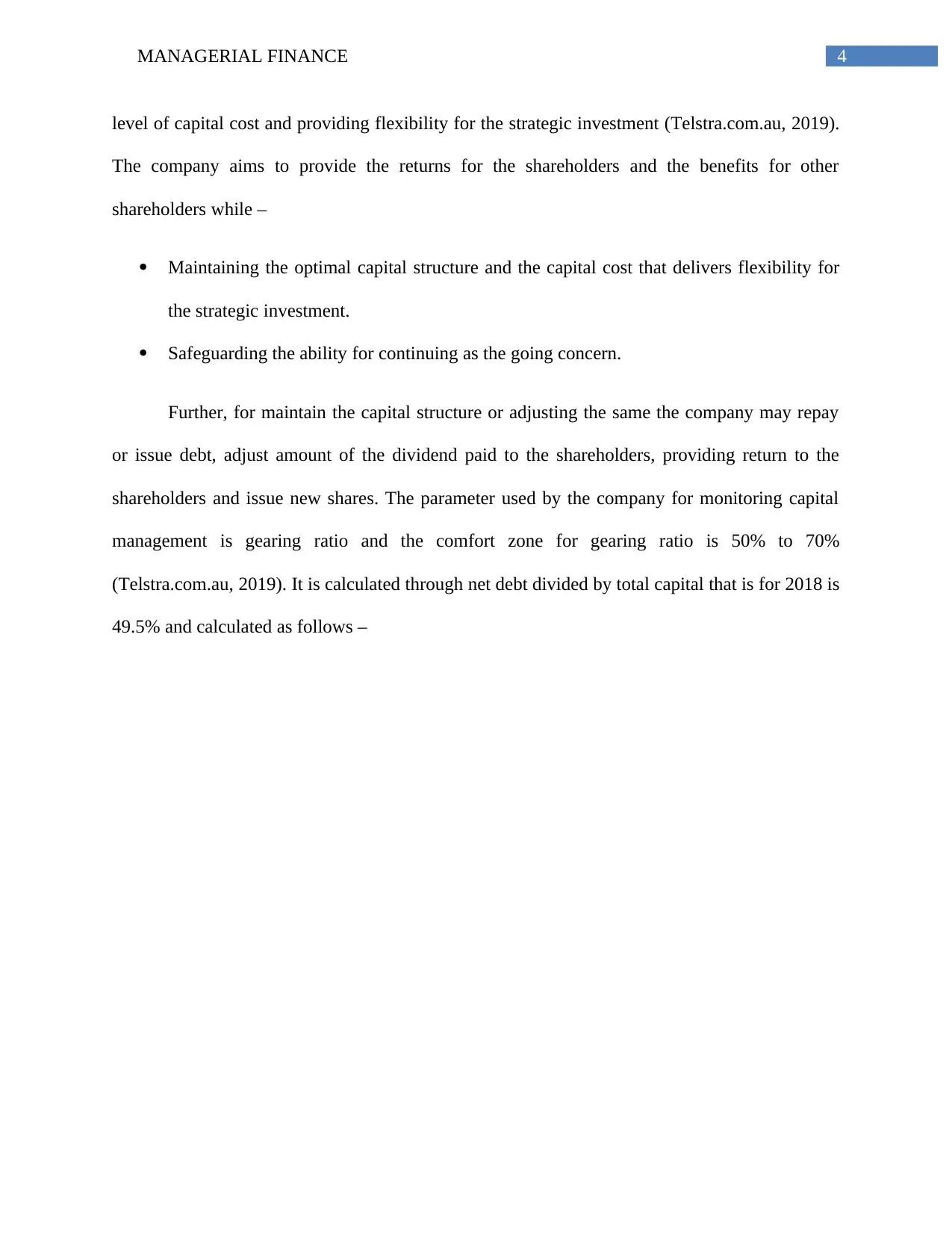
4MANAGERIAL FINANCE
level of capital cost and providing flexibility for the strategic investment (Telstra.com.au, 2019).
The company aims to provide the returns for the shareholders and the benefits for other
shareholders while –
Maintaining the optimal capital structure and the capital cost that delivers flexibility for
the strategic investment.
Safeguarding the ability for continuing as the going concern.
Further, for maintain the capital structure or adjusting the same the company may repay
or issue debt, adjust amount of the dividend paid to the shareholders, providing return to the
shareholders and issue new shares. The parameter used by the company for monitoring capital
management is gearing ratio and the comfort zone for gearing ratio is 50% to 70%
(Telstra.com.au, 2019). It is calculated through net debt divided by total capital that is for 2018 is
49.5% and calculated as follows –
level of capital cost and providing flexibility for the strategic investment (Telstra.com.au, 2019).
The company aims to provide the returns for the shareholders and the benefits for other
shareholders while –
Maintaining the optimal capital structure and the capital cost that delivers flexibility for
the strategic investment.
Safeguarding the ability for continuing as the going concern.
Further, for maintain the capital structure or adjusting the same the company may repay
or issue debt, adjust amount of the dividend paid to the shareholders, providing return to the
shareholders and issue new shares. The parameter used by the company for monitoring capital
management is gearing ratio and the comfort zone for gearing ratio is 50% to 70%
(Telstra.com.au, 2019). It is calculated through net debt divided by total capital that is for 2018 is
49.5% and calculated as follows –
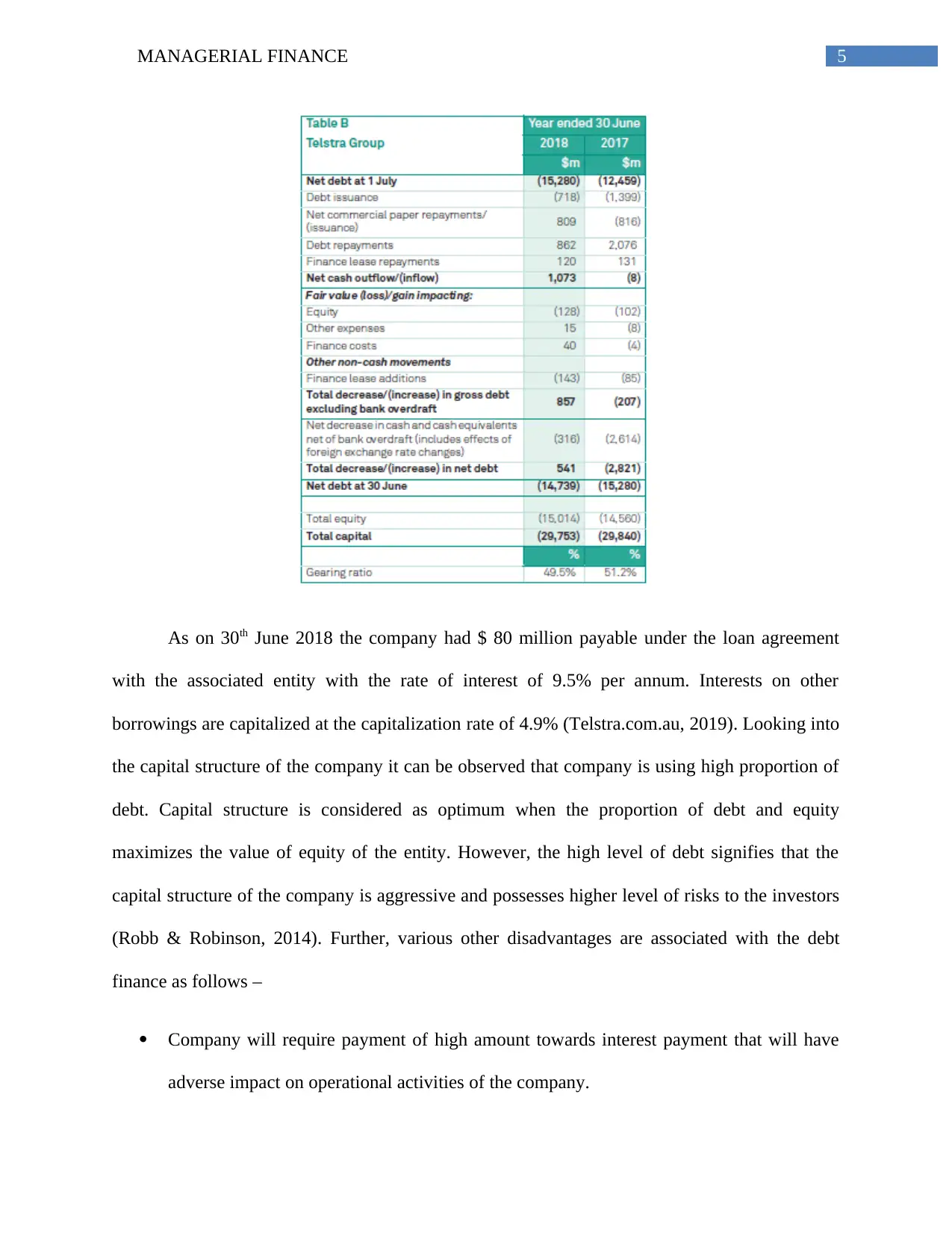
5MANAGERIAL FINANCE
As on 30th June 2018 the company had $ 80 million payable under the loan agreement
with the associated entity with the rate of interest of 9.5% per annum. Interests on other
borrowings are capitalized at the capitalization rate of 4.9% (Telstra.com.au, 2019). Looking into
the capital structure of the company it can be observed that company is using high proportion of
debt. Capital structure is considered as optimum when the proportion of debt and equity
maximizes the value of equity of the entity. However, the high level of debt signifies that the
capital structure of the company is aggressive and possesses higher level of risks to the investors
(Robb & Robinson, 2014). Further, various other disadvantages are associated with the debt
finance as follows –
Company will require payment of high amount towards interest payment that will have
adverse impact on operational activities of the company.
As on 30th June 2018 the company had $ 80 million payable under the loan agreement
with the associated entity with the rate of interest of 9.5% per annum. Interests on other
borrowings are capitalized at the capitalization rate of 4.9% (Telstra.com.au, 2019). Looking into
the capital structure of the company it can be observed that company is using high proportion of
debt. Capital structure is considered as optimum when the proportion of debt and equity
maximizes the value of equity of the entity. However, the high level of debt signifies that the
capital structure of the company is aggressive and possesses higher level of risks to the investors
(Robb & Robinson, 2014). Further, various other disadvantages are associated with the debt
finance as follows –
Company will require payment of high amount towards interest payment that will have
adverse impact on operational activities of the company.
⊘ This is a preview!⊘
Do you want full access?
Subscribe today to unlock all pages.

Trusted by 1+ million students worldwide
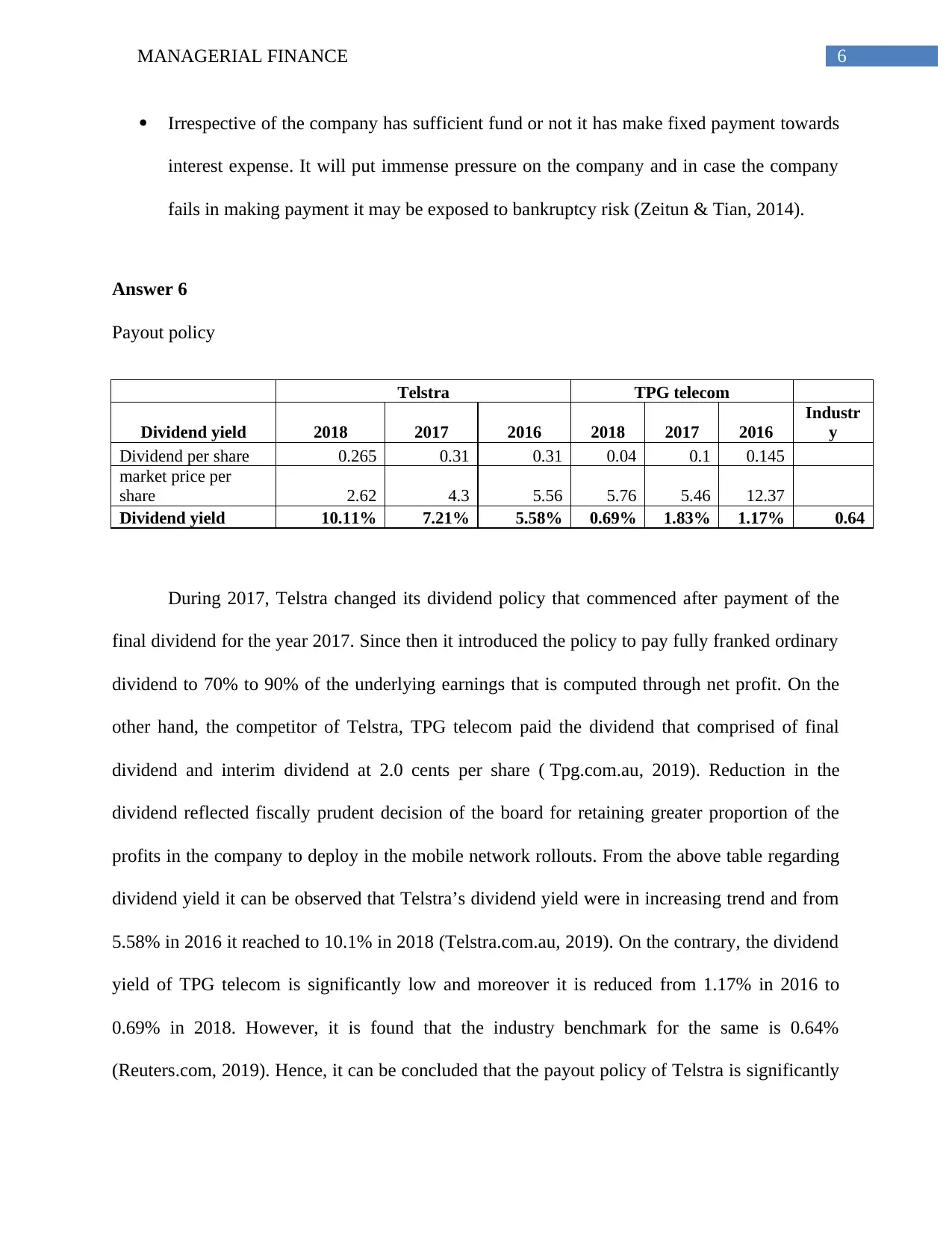
6MANAGERIAL FINANCE
Irrespective of the company has sufficient fund or not it has make fixed payment towards
interest expense. It will put immense pressure on the company and in case the company
fails in making payment it may be exposed to bankruptcy risk (Zeitun & Tian, 2014).
Answer 6
Payout policy
Telstra TPG telecom
Dividend yield 2018 2017 2016 2018 2017 2016
Industr
y
Dividend per share 0.265 0.31 0.31 0.04 0.1 0.145
market price per
share 2.62 4.3 5.56 5.76 5.46 12.37
Dividend yield 10.11% 7.21% 5.58% 0.69% 1.83% 1.17% 0.64
During 2017, Telstra changed its dividend policy that commenced after payment of the
final dividend for the year 2017. Since then it introduced the policy to pay fully franked ordinary
dividend to 70% to 90% of the underlying earnings that is computed through net profit. On the
other hand, the competitor of Telstra, TPG telecom paid the dividend that comprised of final
dividend and interim dividend at 2.0 cents per share ( Tpg.com.au, 2019). Reduction in the
dividend reflected fiscally prudent decision of the board for retaining greater proportion of the
profits in the company to deploy in the mobile network rollouts. From the above table regarding
dividend yield it can be observed that Telstra’s dividend yield were in increasing trend and from
5.58% in 2016 it reached to 10.1% in 2018 (Telstra.com.au, 2019). On the contrary, the dividend
yield of TPG telecom is significantly low and moreover it is reduced from 1.17% in 2016 to
0.69% in 2018. However, it is found that the industry benchmark for the same is 0.64%
(Reuters.com, 2019). Hence, it can be concluded that the payout policy of Telstra is significantly
Irrespective of the company has sufficient fund or not it has make fixed payment towards
interest expense. It will put immense pressure on the company and in case the company
fails in making payment it may be exposed to bankruptcy risk (Zeitun & Tian, 2014).
Answer 6
Payout policy
Telstra TPG telecom
Dividend yield 2018 2017 2016 2018 2017 2016
Industr
y
Dividend per share 0.265 0.31 0.31 0.04 0.1 0.145
market price per
share 2.62 4.3 5.56 5.76 5.46 12.37
Dividend yield 10.11% 7.21% 5.58% 0.69% 1.83% 1.17% 0.64
During 2017, Telstra changed its dividend policy that commenced after payment of the
final dividend for the year 2017. Since then it introduced the policy to pay fully franked ordinary
dividend to 70% to 90% of the underlying earnings that is computed through net profit. On the
other hand, the competitor of Telstra, TPG telecom paid the dividend that comprised of final
dividend and interim dividend at 2.0 cents per share ( Tpg.com.au, 2019). Reduction in the
dividend reflected fiscally prudent decision of the board for retaining greater proportion of the
profits in the company to deploy in the mobile network rollouts. From the above table regarding
dividend yield it can be observed that Telstra’s dividend yield were in increasing trend and from
5.58% in 2016 it reached to 10.1% in 2018 (Telstra.com.au, 2019). On the contrary, the dividend
yield of TPG telecom is significantly low and moreover it is reduced from 1.17% in 2016 to
0.69% in 2018. However, it is found that the industry benchmark for the same is 0.64%
(Reuters.com, 2019). Hence, it can be concluded that the payout policy of Telstra is significantly
Paraphrase This Document
Need a fresh take? Get an instant paraphrase of this document with our AI Paraphraser

7MANAGERIAL FINANCE
better as compared to both its competitor TPG Telecom as well as the industry benchmark
(Floyd, Li & Skinner, 2015).
better as compared to both its competitor TPG Telecom as well as the industry benchmark
(Floyd, Li & Skinner, 2015).
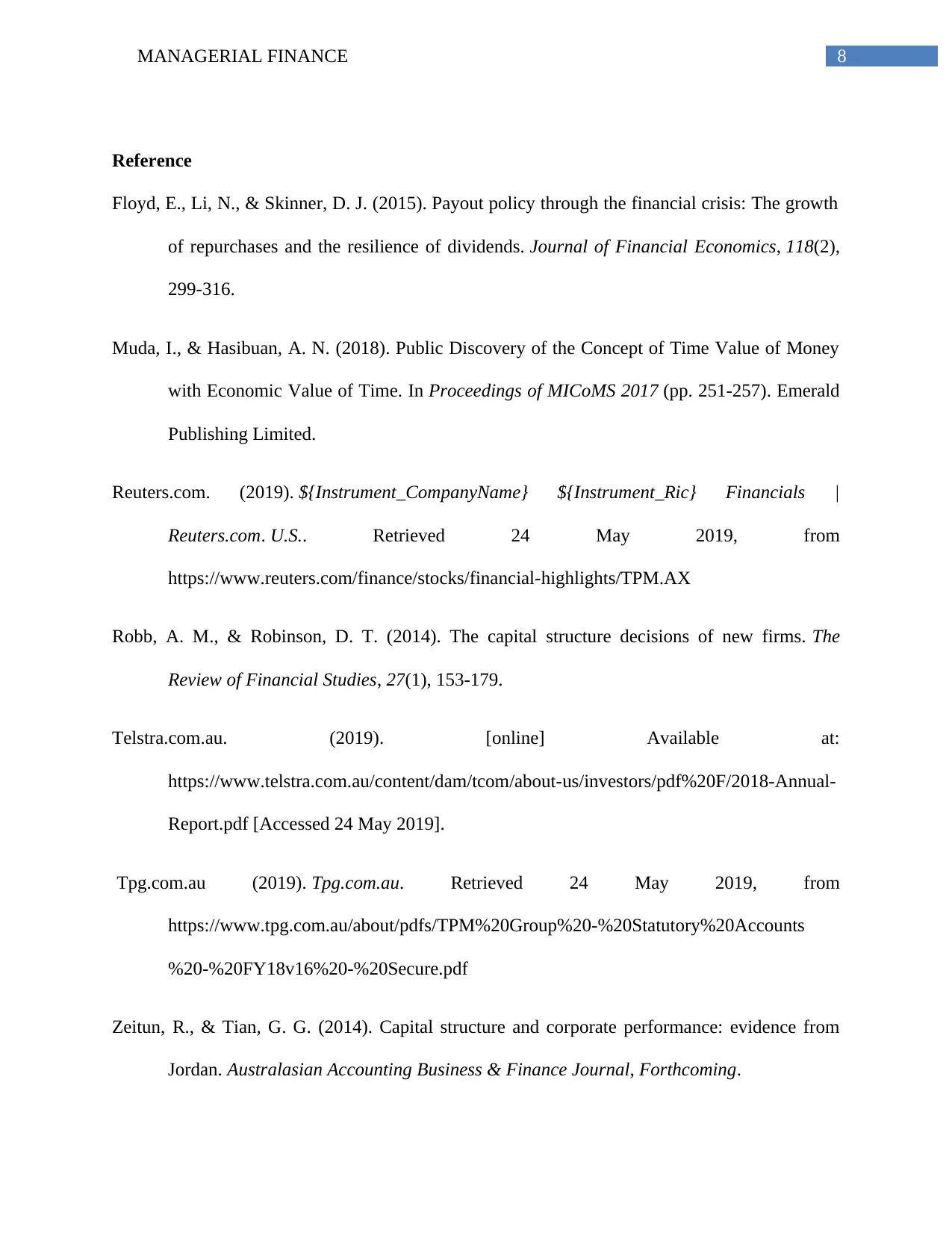
8MANAGERIAL FINANCE
Reference
Floyd, E., Li, N., & Skinner, D. J. (2015). Payout policy through the financial crisis: The growth
of repurchases and the resilience of dividends. Journal of Financial Economics, 118(2),
299-316.
Muda, I., & Hasibuan, A. N. (2018). Public Discovery of the Concept of Time Value of Money
with Economic Value of Time. In Proceedings of MICoMS 2017 (pp. 251-257). Emerald
Publishing Limited.
Reuters.com. (2019). ${Instrument_CompanyName} ${Instrument_Ric} Financials |
Reuters.com. U.S.. Retrieved 24 May 2019, from
https://www.reuters.com/finance/stocks/financial-highlights/TPM.AX
Robb, A. M., & Robinson, D. T. (2014). The capital structure decisions of new firms. The
Review of Financial Studies, 27(1), 153-179.
Telstra.com.au. (2019). [online] Available at:
https://www.telstra.com.au/content/dam/tcom/about-us/investors/pdf%20F/2018-Annual-
Report.pdf [Accessed 24 May 2019].
Tpg.com.au (2019). Tpg.com.au. Retrieved 24 May 2019, from
https://www.tpg.com.au/about/pdfs/TPM%20Group%20-%20Statutory%20Accounts
%20-%20FY18v16%20-%20Secure.pdf
Zeitun, R., & Tian, G. G. (2014). Capital structure and corporate performance: evidence from
Jordan. Australasian Accounting Business & Finance Journal, Forthcoming.
Reference
Floyd, E., Li, N., & Skinner, D. J. (2015). Payout policy through the financial crisis: The growth
of repurchases and the resilience of dividends. Journal of Financial Economics, 118(2),
299-316.
Muda, I., & Hasibuan, A. N. (2018). Public Discovery of the Concept of Time Value of Money
with Economic Value of Time. In Proceedings of MICoMS 2017 (pp. 251-257). Emerald
Publishing Limited.
Reuters.com. (2019). ${Instrument_CompanyName} ${Instrument_Ric} Financials |
Reuters.com. U.S.. Retrieved 24 May 2019, from
https://www.reuters.com/finance/stocks/financial-highlights/TPM.AX
Robb, A. M., & Robinson, D. T. (2014). The capital structure decisions of new firms. The
Review of Financial Studies, 27(1), 153-179.
Telstra.com.au. (2019). [online] Available at:
https://www.telstra.com.au/content/dam/tcom/about-us/investors/pdf%20F/2018-Annual-
Report.pdf [Accessed 24 May 2019].
Tpg.com.au (2019). Tpg.com.au. Retrieved 24 May 2019, from
https://www.tpg.com.au/about/pdfs/TPM%20Group%20-%20Statutory%20Accounts
%20-%20FY18v16%20-%20Secure.pdf
Zeitun, R., & Tian, G. G. (2014). Capital structure and corporate performance: evidence from
Jordan. Australasian Accounting Business & Finance Journal, Forthcoming.
⊘ This is a preview!⊘
Do you want full access?
Subscribe today to unlock all pages.

Trusted by 1+ million students worldwide

9MANAGERIAL FINANCE
1 out of 10
Related Documents
Your All-in-One AI-Powered Toolkit for Academic Success.
+13062052269
info@desklib.com
Available 24*7 on WhatsApp / Email
![[object Object]](/_next/static/media/star-bottom.7253800d.svg)
Unlock your academic potential
Copyright © 2020–2025 A2Z Services. All Rights Reserved. Developed and managed by ZUCOL.





